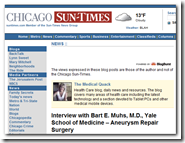This is still listed as a clinical trial, and there is either a small incision in the chest, or no incision with navigating through the femoral artery in the patient’s leg. This option will enable patients, who normally would not be able to survive a full open heart surgery to have the opportunity to have a heart valve replaced.
The procedure takes 90 minutes, compared to a much longer procedure with full open heart surgery, whereby the entire chest area is cut open, ribs  expanded, and with around a 3 month recovery. It is amazing what technology is creating these days with procedures as such that are saving lives. The procedure is still considered a trial at Phase 3.
expanded, and with around a 3 month recovery. It is amazing what technology is creating these days with procedures as such that are saving lives. The procedure is still considered a trial at Phase 3.
Not too long ago I did an interview with Dr. Muhs from Yale Medical Center relative to aneurisms and the processes are very similar as far as using a catheter and not having full open heart surgery and was also featured in the Chicago Sun Times.
As with aneurisms, aortic valve disease can eventually lead to death in some cases as well. Additional information and videos that show and describe the procedure can be found on the Edwards website.
As was mentioned in my interview with Dr. Muhs, I might also tend to think that follow up visits with the doctor would also be necessary to follow up to check and make sure the valve is still in place and functioning properly. Minimally invasive surgery is making some real strides in the last few years, especially with endovascular procedures. BD
An innovative approach for implanting a new aortic heart valve without open-heart surgery is being offered to patients at New York-Presbyterian Hospital/Columbia University Medical Center. Known as the PARTNER (Placement of AoRTic traNscathetER valves) trial, this Phase 3 multicenter study is being led by national co-principal investigators Dr. Martin Leon and Dr. Craig Smith and is focused on the treatment of patients who are at high risk or not suitable for open-heart valve replacement surgery.
The Edwards SAPIEN transcatheter heart valve, made of bovine pericardial tissue leaflets hand-sewn onto a metal frame, is implanted via one of two catheter-based methods -- either navigated to the heart from the femoral artery in the patient's leg, or through a small incision between the ribs and into the left ventricle. It is then positioned inside the patient's existing valve, using a balloon to deploy the frame, which holds the artificial valve in place. Both procedures are performed on a beating heart, without the need for cardiopulmonary bypass and its associated risks.
Heart valves implanted without open-heart surgery
Related Reading:






Open heart surgery successfully corrects congenital defect of the organ, replaces defective valves and repairs blocked arteries. However, in a coronary artery bypass graft surgery, sometimes a second surgery is required if restenosis sets in. The surgery has become fairly common, with an increased survival rate. Nevertheless, the risk factor is definitely higher in the case of older people and those with related medical conditions of a serious nature.
ReplyDelete